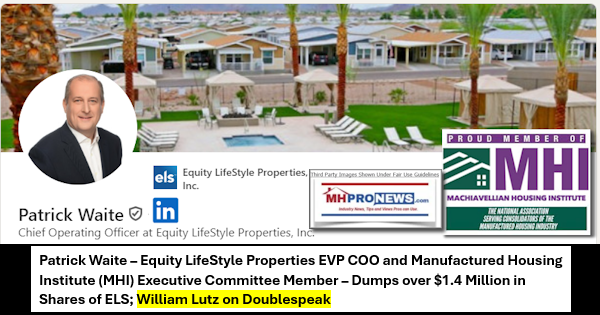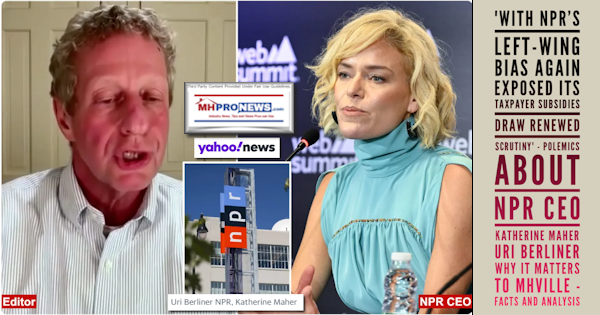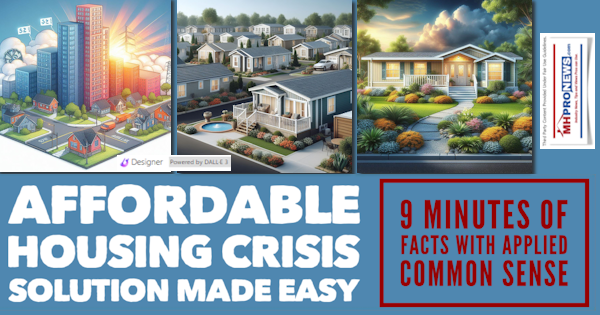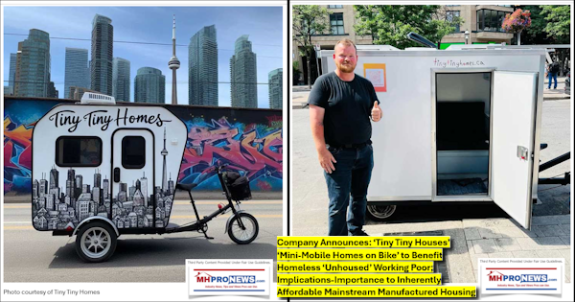Do you want to grow your business by 400% to 1600%? Want the simple tool to help make this happen? Well, then, please read on!
The Summer of 2010 has been a busy one for many of us. We may not be selling all the factory built homes we desire, but we’ve made some marginal improvements during a time that housing in general continues to struggle. We’ve seen a dizzying array of issues face our Industry, from finance, to regulatory and more.
Let’s be candid, we could use some help on Capitol Hill!
During the MHI Summer Meeting, Thayer Long said that over 80 Industry Members made personal visits to Congress. A lobbyist – as well as Congressional representatives and their staffs – have expressed to me how important it is for your Senator or Congressman to hear from you, personally. Lobbying is needed in this day and age. But no one does it like YOU can do it. A letter, fax or email from you to your Congressman or Senators can have an important impact.
MHARR and MHI have both advocated ‘engagement’ with Congress during this critical period of time for our Industry.
With the above in mind, I put together the message that follows. This was done with some very helpful polishing assistance from our Associate Editor Catherine Frenzel, whom I hereby publicly thank and acknowledge for her many contributions behind the scenes to our ever improving efforts at MHMSM.com. I sent this off by email and in one case also by fax to each of the three who represent me.
I share the guts of it for your consideration. You are welcome to use this, or elements from this, in your own outreach to Congress. I won’t say this is comprehensive, it doesn’t touch on the SAFE Act issue for example. But what it does is outline a variety of points that are important for us to achieve our potential as an Industry!
I am mindful that last month, we flooded the FHFA with “thousands” of comments! There were so many, that it reportedly shut down their email posting system. Let’s approach Congress with that same type of vigor.
Take 20 minutes to an hour, and just do this. Reach out to your Congressperson and your two U.S. Senators. Please, do it today if you can, but don’t let it fall off your radar. You are in this Industry. You have associates whose jobs depend on this Industry. Think, we could grow 400%-1600% by some estimates, if these items are addressed successfully in Washington.
That should be all the incentive that you and everyone who works with you needs. I guarantee you, that if Congress gets floods of messages, like this, or in your own words, we will see action in 2010. I personally sent this on our letterhead.

==> Here’s the meat Tony sent to U.S. Legislators. Feel free to use it. <==
Dear Congressman/Senator
I am a resident of Glenview, IL and a member of the Manufactured Housing Institute (MHI), an industry trade association that is based in Washington, DC. I am writing you today as the publisher of Illinois-based Manufactured Home Marketing Sales Management trade magazine (www.MHMSM.com), the Industry’s premier news and views resource, with 30,300 readers in July 2010. Our readers include owners, executives, association leaders and management of companies with more than 500,000 people still working across the U.S.
I have been working in various aspects of the Manufactured Housing Industry since 1981. To my recollection, we have never faced so many challenges as an Industry, as we do now.
We need your help, please!
INTRODUCTION
Danny Ghorbani, president and CEO of the Manufactured Housing Association for Regulatory Reform (MHARR), has stated in interviews with us that the industry has many friends on Capitol Hill. In fact, he has told me personally that we are “a dream industry” and loved by many elected officials, because we provide affordable quality homes for people of low to moderate income; we do so without subsidies and can also serve people of any income with appealing, safe homes that cost some 30-40 percent less than conventional construction. In states such as Texas, manufactured housing has provided as much as one-third of all new housing starts, but due to financing and regulatory challenges, we have slipped from a high of more than 372,000 homes in 1998, to just under 50,000 new homes sold by manufacturers in 2009.
At precisely the time that our great nation needs more jobs and affordable, quality homes, our Industry faces serious challenges. Congress has given the industry great legislation such as the Manufactured Housing Improvement Act of 2000 (MHIA 2000), FHA Title I Reform and the GSE’s “Duty to Serve” underserved markets provision passed in 2008. Yet implementing this legislation has been a real issue.
There are voices in Washington who now say we should turn away from supporting home ownership, and turn instead to providing support for rental housing. Where is the logic in that thought? Someone has to own a home, be it a rental or owner occupied! Support for rentals is like saying we will pump money into the hands of those who have it – the landlords – rather than give millions an opportunity to own. Those millions could build equity and improve their lives if affordable housing is made available to them.
The problem with the mortgage meltdown was due in part to forces putting people into homes they couldn’t afford, due to terms and qualifying that were too lax or counterproductive to long-term ownership and economic interests. But the idea of home ownership should not be discarded because of a breakdown or abuses of the system. That would be like saying that we should jail honest citizens because some people commit crimes.
Rather, the answer is that we need to create jobs through the availability of affordable quality homes! The manufactured housing industry, which has served the nation for decades, provides the answer.
THE CHALLENGES
Before addressing specific issues, let me paint a picture for you of what America faces and why manufactured homes and factory built housing in general makes so much sense.
1 The U.S. population is growing larger.
Based on the middle-series projections, the nation’s population is projected to increase to 392 million by 2050 — more than a 50 percent increase from the 1990 population. See: http://www.census.gov/population/www/pop-profile/natproj.html
2 The U.S. population will be older than it is now.
In all of the projection series, the future age structure of the population will be older than it is now. The last of the Baby-Boom population will reach age 65 in the year 2029. By that time, the Baby-Boom population is projected to be only about 16 percent of the total population. See: http://www.census.gov/population/www/pop-profile/natproj.html
3 The U.S Housing stock is aging.
The median age of US Housing Stock is 36 years. See: http://portal.hud.gov/portal/page/portal/HUD/press/press_releases_media_advisories/2010/HUDNo.10-138 (July 1, 2010)
An early report shows that the median year American homes were built was in 1969.
Most American housing is located in metropolitan areas; www.huduser.org/periodicals/ushmc/fall00/summary-2.html
Age, Size and Equipment Characteristics of U.S. Households: More than 90 percent of the current U.S. housing stock was built before 1990. See:
http://eetd.lbl.gov/ie/pdf/LBNL-43640.pdf
When we think about the lower energy standards of those older housing units, and the fact that many homes are 70-100+ years old, there is no question that American housing needs updating.
4 The current economic instability means lower earnings for millions of Americans.
President Obama has twice gone to Elkhart, Indiana, where unemployment is among the highest in the country. Elkhart is also home to many manufactured housing producers. The promise of jobs that were made there could be kept by providing the necessary political and regulatory support for manufactured housing.
VIABLE SOLUTIONS
To me and thousands of others in our Industry, when we look at the facts, we see a picture that says this:
- The real driver behind the U.S. Economy for decades has been housing.
- We need housing for a growing population. There is likely to be a large demand for smaller houses and more affordable houses
- We need to replace housing that is aging or in poor condition, including 2 million pre 1976 mobile homes (i.e., pre-HUD Code).
- As the population ages, we will need more single-level and affordable housing
- Only manufactured and modular construction of homes can rapidly meet the needs of the nation during a disaster.
- We need jobs, we need manufacturing…
- …so we need manufactured housing now more than ever!
We in the manufactured housing industry have production; we have an energy-efficient and affordable quality product. We have customers; we have demand. So the problem is not in our industry – it found in various bottlenecks is in Washington, DC.
WHAT CAN CONGRESS DO TO HELP?
HUD’s Teresa Payne told the MHI members at our Summer Meeting in Washington, DC this past July 13-15th, 2010, that “Manufactured Housing Still Rocks!” See
http://www.mhmarketingsalesmanagement.com/blogs/tonykovach/manufactured-housing-still-rocks/
That said, here are issues that in many cases have been hampered in Washington, DC, that are crying out for Congressional action.
- Financing is the key to any big ticket sale. Financing helps retailers sell more new homes, and proper financing would help consumers re-sell used manufactured homes. There are currently some 20,000,000 such home owners in the U.S. and cutting off financing to them is like trapping them in their homes, should they need or want to sell. The next two points could specifically address this critical need for the Industry and the millions of people it serves.
- GSE’s “Duty to Serve.” Congress passed this in 2008, and the GSEs have stonewalled. Let me share an analogy. If a citizen fails to abide by the law, we get fined, jailed or perhaps strung up! How can the FHFA fail to move on getting the GSE’s to implement the will of Congress? What is the consequence for ignoring the law?
- FHA Title I reform. The standards and rules that FHA has put in place will allow only the largest lenders to do FHA loans, due to the high capitalization requirements. While there are efforts underway to move this ahead, Congressional intervention could speed the process. Letters from the House and Senate to FHA on making the entry requirements for lenders on the Title I Program could make a difference!
- SBA Floorplan lending. Congressman Joe Donnelley of IN is seeking bi-partisan support for a measure to extend and improve the SBA floor plan lending program. Without wholesale (floor plan) lending, many retailers, developers and community operators simply can’t purchase homes from factories to display for retail buyers to see them. Donnelley’s measure could aid the industry considerably in this practical need, along with giving similar support for the RV and the Automotive Industries. H.R. 5734. The companion bill was the Small Business Lending Fund Act of 2010, Sen. Mary Landrieu, D-La.
- Passing the Energy Efficient Manufactured Housing Act. Senate Energy and Natural Resources Committee adopted the Energy Efficient Manufactured Housing Act (S. 1320). The House passed companion legislation (H.R. 5019) in May. This would help replace older mobile homes, – i.e., those factory-constructed houses built prior to the passage of the HUD Code for manufactured housing went into effect on June 15, 1976 – with new Energy-Star-qualified homes. This helps the most poor and elderly.
- MHCC and HUD. MHARR has expressed grave concerns that the intent of Congress in creating the Manufactured Housing Consensus Committee (MHCC) is being neutralized by HUD. I’ve personally spoken with members of the MHCC, who echo MHARR‘s Danny Ghorbani’s concerns. If regulators are allowed to push forward any regulation without an effective voice for consumers and manufacturers, then regulators – no matter how well intentioned – can de facto wreck havoc on the Industry they regulate. HUD should have a clarification of the intent of Congress in passing the MHIA of 2000, which clearly spells out the fact that HUD must go through the MHCC process and can’t impose its will outside of and apart from expressed approval the MHCC process. Some regulatory issues now pending, include:
- RE: RIN 2502-A172 Manufactured Home Construction and Safety Standards, Test Procedures for Roof Trusses
- Docket Number FR-5295-P-01; RIN 2502-A183 On-Site Completion of Construction of Factory Built Manufactured Homes.
- It should be noted that the intent of Congress was to make manufactured housing performance based, as opposed to a proscriptive code. This would allow for technological advances to move the Industry ahead, control material waste and costs and give the best possible product to the consumer. The MHCC process was supposed to foster that, but as noted, a discussion with a number of MHCC members indicates that HUD is now trying to effectively over-ride/neutralize the Committee, contrary to the intent of Congress in passing the MHIA of 2000. Let’s not hamstring American ingenuity. A letter to HUD on this issue from your office would be helpful.
- Federal Pre-emption of HUD Code Manufactured Homes. Pre-emption simply means that the federal HUD Code pre-empts local building codes. This was a marvelous idea that dated back to the original passage of the HUD Code by Congress back in 1974. Pre-emption – in theory – simplified and reduced those costs for construction that were mostly regulatory in nature. I say ‘in theory,’ because practically speaking, local jurisdictions often ignore pre-emption! Nor does HUD often impose its authority in those cases where pre-emption is ignored. Let me give another analogy to make this point. If the FBI shows up at a crime scene and asserts federal jurisdiction, the local law enforcement agencies have to stand aside. The same should be true with the HUD Code for Manufactured Housing! Local jurisdictions don’t attempt to over-ride HUD on fair housing laws, why does HUD allow it with respect Manufactured Housing? A letter to HUD asking them to enforce federal pre-emption may set the stage for more vigorous action by HUD when state or local jurisdictions ignore federal law regarding manufactured housing placements and related regulatory issues. The widespread use of the HUD Code could and would flourish if pre-emption and the points made above would be enforced.
MYTHS
There are many myths about manufactured housing that we have tackled in various “Industry in Focus Reports” by our Eric Miller.
These require a free sign up and login, which is linked below:
http://www.mhmarketingsalesmanagement.com/user-registration
The point is that today’s manufactured homes are not yesteryear’s ‘mobile homes.’ They should no longer be treated as mobile homes, they should be treated on par with conventional housing! America needs this industry, and you and Congress have an opportunity to support a jobs creation simply be supporting the items noted herein.
SUMMARY
I could summarize the news stories above by saying that insurance, university, government and other studies prove that today’s manufactured housing is stronger, smarter, safer, stylish and offers major savings. Today’s Manufactured Housing (as opposed to pre-HUD Code mobile homes, those houses built in factories prior to June 15, 1976, when the HUD Code for Manufactured Housing took effect) is in many ways superior to conventional construction. It is greener than conventional building can be. Size for size, manufactured homes are more energy efficient and less costly to maintain. Manufactured homes create jobs, and offers affordable housing to millions of Americans.
To show the potential appeal for today’s manufactured homes, you can visit our photo gallery at:
http://www.mhmarketingsalesmanagement.com/photo-gallery
The point is this. The Industry has lost dozens of manufacturing facilities. It has seen what once were its two largest HUD Code manufactured housing builders go into bankruptcy, along with many smaller manufacturers that have vanished. Had Congressional legislation been properly implemented, much of this could have been avoided.
In our July 2010 interview with Congressman Walter Jones (R-NC), he stated to us that
- Congress can issue letters to regulators.
- It can hold hearings.
- As needed, it can pass legislation.
There are some items that need a vote or co-sponsorship of legislation that is ending. At the very least, House or Senate Members can send a letter saying, ‘What gives?”
We need some of each of these actions – from you, please.
Twenty million Americans who live in manufactured housing or pre-HUD Code mobile homes and the 500,000+ jobs the Industry represents are counting on your support. Please let your voice be heard and take action on any of the points outlined above.
Thank you.
Respectfully,
L. A. ‘Tony’ Kovach
Publisher, http://www.MHMSM.com
tony@MHMSM.com
847-730-3692


































